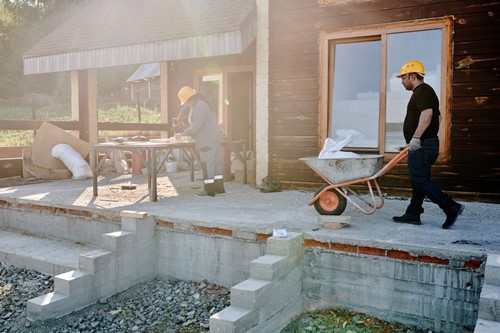
In both existing homes and new construction, there are several common types of foundations for houses. Each has their advantages and disadvantages, including specific maintenance requirements and climate-specific considerations.
Whether you’re building a new home or want to learn more about how to care for your existing home, it’s worth exploring the three major types of foundations used for houses:
Basement foundation
Basement foundations are essentially holes dug beneath the house, matching most or all of the ground-level square footage. Builders use concrete footings around the edge of the basement space as a frame for the foundation, then follow with beams, walls and a concrete slab at the bottom.
Basement foundations can add extra living space to the home, potentially doubling the square footage if finished. Otherwise, unfinished basements serve as valuable storage space and shelter in case of extreme weather.
Concrete slab foundation
Concrete slab foundations are made of a simple, flat layer of concrete situated slightly below the surface of the ground. This is one of the simplest foundation types to install, involving a wire mesh and reinforcing bars within the concrete for extra stability.
Slab foundations are best for warmer regions, as frozen ground can cause cracks and shifts in the concrete. However, in the right conditions, a slab foundation will not develop weak spots or crumble over time.
Crawl space foundation
Crawl space foundations have characteristics of both a basement and a slab foundation. They’re built using small concrete footings called stem walls, which create a slightly elevated space beneath the home. While you can’t use a crawl space as living space, it can be perfect for storage and access to plumbing or electrical wiring.
Crawl space foundations can help keep the home safe from flood damage, earthquake damage and termites. One disadvantage of this foundation type is the vulnerability to mold, mildew and pests who might like to make the shelter their home.
There are other types of foundations, like wood foundations and pier foundations, which are typically more specific to certain regions and types of home. There are also variations of the foundations found in this article, such as slab on grade foundations and daylight basements.
Regardless, the more you know about these three common types of concrete foundation, the more prepared you’ll be to take care of your own - whether in your current home or brand-new construction.
About the Author

Wendy Wiegand
As a premier real estate agent in Carlsbad, I’m here to provide you with all the resources and information you need to buy or sell real estate. I work with buyers and sellers in Carlsbad, Encinitas, Oceanside, San Marcos, Vista and the surrounding areas and I’ve had extensive training in the latest real estate marketing strategies. I’m confident that I can offer you knowledge and tools most other agents can’t.
I believe in service, both to my clients and our community. When working with clients, you can be assured I am focused on providing the most comprehensive and dedicated effort so that you can achieve the best results possible when buying or selling real estate. I am also deeply involved in serving our community, as you and I all call it home. I have been a member of Rotary since 2003, have been an active member of the Carlsbad Chamber of Commerce since 2006, and serve on the board of the Agua Hedionda Lagoon Foundation. Perhaps my even deeper service to my clients and our community is Wiegand Realty’s participation in Business for a Cause.
Contact me so I can keep you updated on the latest real estate activities in our community and answer any questions you may have.
Thanks and I look forward to assisting in all of your real estate needs!
Check out all my Client Reviews at Rate My Agent - https://www.ratemyagent.com/real-estate-agent/wendy-wiegand-bk497/sales/reviews